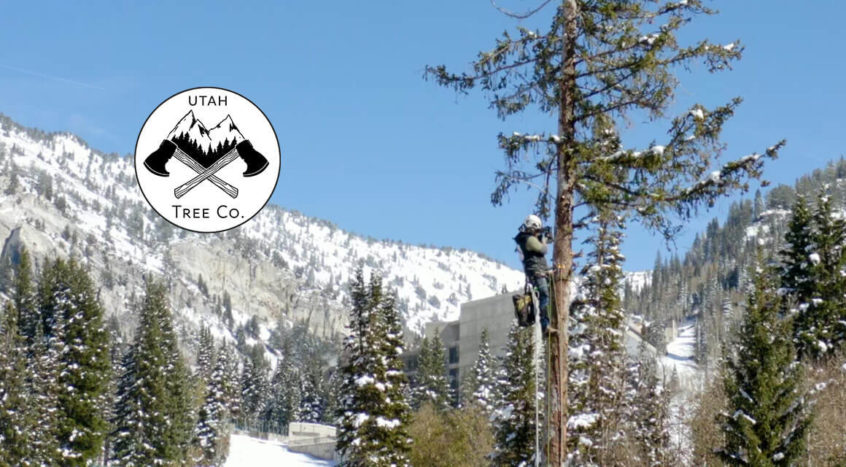With winters almost upon us, homeowners need to start thinking about protecting their trees, and shrubs from damage inflicted by wind, snow, and freezing temperatures. After all, you don’t want these elements to hurt or kill your foliage, leaving your backyard looking bare in spring!
Of course, removing snow can help protect your trees and plants, but you can do more to ensure that your trees and plants get through the cold weather with relative ease.
But first, let’s first consider some of the biggest challenges that freezing temperatures present to our green friends.
As an experienced tree care services provider, we know that temperature drops can damage plant tissues that haven’t hardened off for the winter. Dry winds and the winter sun can be extremely harsh on them. Further, the soil may freeze, which means it won’t be able to absorb water to make up for the moisture loss caused by evaporation and transpiration.
And that’s not all. Mid-winter thawing can trick foliage into breaking dormancy before time, making them susceptible to destruction in the very next cold spell.
On top of that, rodents, deer, and other animals can destroy leaves and twigs due to the scarcity of food during the long winter.
But fret not, we’re here to help.
Basic Steps to Prepare Trees for the Frosty Season
Needless to say, healthy trees are better equipped to survive the winter than unhealthy or new ones. Trees that have trouble growing due to inadequate sunlight, insufficient water or fertilizers, or damage from animals, insects, or diseases are likely to perish in the cold weather. This is why you should start protecting your trees and foliage during the growing season through autumn.
Here are a few helpful tips:
- Avoid any kind of tree trimming after midsummer. Pruning leads to new growth and delays dormancy, making the tree or plant vulnerable to the winter weather.
- To help your plants harden off adequately for winters, stop fertilizing them six weeks prior to the first frost forecast.
- Continue to water your trees and plants throughout fall until the ground freezes. The water should penetrate 12-18 inches deep to properly reach the roots.
- Consider using shrub jackets or protective covers for protection against dry winds, bright winter sun, animal activity, and salt spray.
Effective Ways of Protecting Trees in the Cold Weather
Protecting trees, especially newly-planted ones, from the cold essentially boils down to proactively shielding them completely from the harsh weather.
a) Protecting Fruit Trees
Fruit trees or those that have a thin bark are highly susceptible to sun scald, wherein the bark warms up and breaks dormancy. However, as soon as it gets cold again, the tissue freezes and dies, leaving large sunken areas on the bark. Moreover, the cold can be hard on the fruit tree’s buds, making it struggle to produce fruits in the spring.
As a nature-loving tree care services company, we’d hate to see this happen to your trees. Mentioned ahead are a few steps you can take before the temperature plummets to protect your fruit trees.
- Cover the tree’s trunk with a plastic tree guard or any other impervious protective wrap to shield it from sun-scald.
- You can use a frost shield to protect your fruit trees. It adds a protective layer over them and prevents moisture loss.
- You may also invest in paper or wire tree guards as they are an easy way to protect young trees and their bark from scavenging animals.
b) Safeguarding Shrubs
You can protect your shrubs by taking the following steps:
- Water the shrubs thoroughly throughout the fall until the ground freezes. This is particularly important if you have young plants in your backyard as it will allow them to establish their roots properly. Proper watering in advance is key to giving newly-planted shrubs a fighting chance for survival in the winter.
- Cover your shrub’s bed in mulch to seal in the moisture. Make sure to add a 3-to-4-inch layer of mulch around the young shrub’s bases to insulate the soil. This will help the soil stay frozen and prevent heaving. However, do maintain a tiny bit of space between the mulch and the shrub to allow sufficient breathing space.
- Wrap your young shrubs in loose material, like burlap, for protection against the harsh wind. This will also keep them from freezing or browning. New shrubs are more vulnerable to freezing temperatures and can benefit greatly from burlap.
(Note: If you’re worried about snow covering your shrubs or trees, you can rest assured knowing that snow cover can actually be good for them. A layer of snow can provide moisture and help insulate the soil and roots from changing temperatures.)
c) Protecting Trees from Late Frost
Ask any tree care services provider, and they will confirm that most trees do not react well to fluctuating temperatures. New trees can react badly if springtime weather suddenly turns cold.
Materials like mulch and burlap can be of immense help here by enabling trees to overcome the shock of a sudden temperature drop. Here are a few steps you can take to safeguard your trees from springtime chills.
- Do track the weather forecast to be prepared for unanticipated changes or drops in temperature. Thoroughly water your trees and shrubs one day prior to a freezing day.
- Prevent frost heaving with the help of mulch. Frost heaving refers to a condition where the soil thaws and freezes over and over, causing the roots to rise above the ground, exposing themselves to the harmful cold. This is especially common among young trees as their roots tend to be shallow during their first few winters.
- For added protection, cover the tree or plant with burlap or even a small bedsheet. However, make sure to take the covering off the next morning so the plant doesn’t suffocate or overheat.
At What Temperature Should I Add the Cover?
Most trees do well in temperatures that are 30 degrees Fahrenheit or higher. The risk of freeze damage occurs when the mercury drops down to the low-twenties. This risk increases when the temperature further plunges to under 20 degrees Fahrenheit.
Keeping them safe will requires you to use tree guards or burlap before the temperature starts to fall below 30 degrees.
Conclusion
Cold weather can be extremely hard on trees that stand unprotected against harsh elements such as snow and wind. Newly-planted and young trees are particularly at risk of getting injured or withering because they take time to develop a thick bark and establish their roots firmly. Hopefully, taking the above steps will help you ensure that your trees are ready to weather any winter challenge that comes their way. For more help and specific guidance, do not hesitate to reach out to a trusted tree care services provider.

